 Download PDF
Download PDF
Name: Parthenocissus tricuspidata (Siebold & Zucc.) Planch
Family: Vitaceae, the Grape Family
Common Names: Boston Ivy, Japanese creeper, Japanese Ivy (5,6,8).
Etymology: Parthenocissus is derived from the Greek word parthenos, meaning “virgin” and kissos, meaning “ivy”. Tricuspidata is derived from the Latin word tri, meaning “three” and cuspidatus meaning “pointed”. This refers to characteristic 3-lobed leaves (9, 10).
Botanical synonyms (11,12,13, 30):
Ampelopsis tricuspidata Sieb. & Zucc.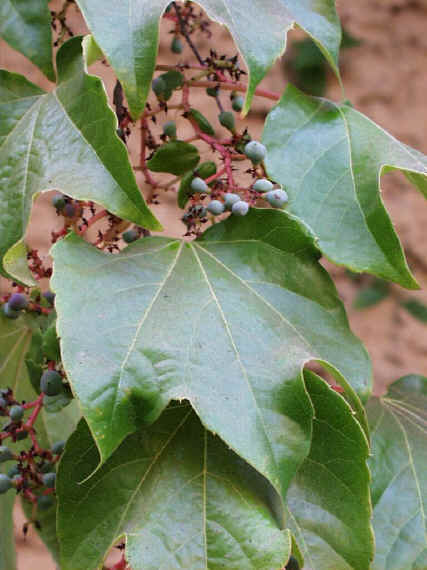
Ampelopsis veitchii hort., nom. inval.
Cissus thumbergii Siebold & Zucc.
Parthenocissus thunbergii (Siebold & Zucc.) Nakai
Psedera thunbergii (Siebold & Zucc.) Nakai
Psedera tricuspidata (Siebold & Zucc.) Rehder
Quinaria tricuspidata (Siebold & Zucc.) Koehne
Vitis inconstans Miq.
Vitis taquetii H. Lév
Vitis thunbergii (Siebold & Zucc.) Druce
Quick Notable Features:
¬ Branched tendrils end in adhesive disks
¬ Alternate leaves with 3 serrated lobes
¬ Dark green leaves change to bright orange-red color during the fall
¬ Blue fruit on red pedicels
¬ Flowers are small, yellow-green, in cymes, often hidden by foliage
Plant Height: P. tricuspidata is a high climbing vine, usually growing 9-15m (1).
Subspecies/varieties recognized: Parthenocissus tricuspidata var. ferruginea W.T.Wang (22)
Most Likely Confused with: Hedera helix, Menispermum canadense, Ampelopsis brevipedunculata, P. vitacea, and P. quinquefolia (18).
Habitat Preference: Grows well in a variety of soil types, but prefers those that are moist. It is moderately tolerant of shading and is often seen on rock and brick walls. Flowers and berries are more likely to be produced if there is some exposure to sunlight (1,4,17).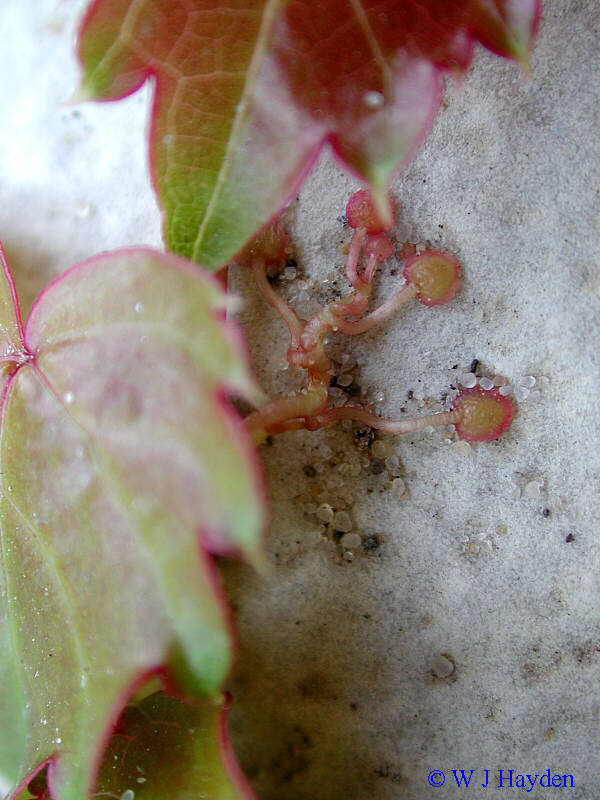
Geographic Distribution in Michigan: It is commonly cultivated in Michigan but does not easily spread. It does not seem to escape in our area (2).
Known Elevational Distribution: The average elevation is 535 meters (1,755 feet). It has been found at altitudes ranging from 0 to 3,312m. It was found in Pyongyang city, North Korea at an elevation of 230m (13,14).
Complete Geographic Distribution: Native to China and eastern Asia. In the USA it exists in the wild in most of the northeast and midwest, with the exceptions of Michigan, Wisconsin, Vermont, New Hampshire, Virginia, and West Virginia (12).
Vegetative Plant Description: A perennial liana with leaves alternate, simple, 3-lobed, with pointed tips. The leaves are usually 10-20cm long with a coarsely serrated margin. A few leaves can be compound with three leaflets. Leaf veins are pubescent. The leaves are shiny, dark green, turning glossy yellow, orange, scarlet, and/or crimson in the fall. The petioles are long, slender, usually 4-12 cm in length, and glabrous or sparsely pubescent. They are usually light green becoming bright orange-red in the fall. Leaves have been seen bearing mites, although no mite domatia are found on the leaves (RJB pers. obs.). The stems are squarish, smooth, and have vertically arranged lenticels. Tendrils attach the stems to walls or other supportive structures via suction-cup holdfasts, known as adhesive disks. The tendrils are located opposite the leaves at nodes. (1,3,5,6,7,8,14,18,19,29).
Climbing Mechanism: P. tricuspidata climbs with branched tendrils that end in adhesive disks. A tendril is made up of a main axis with 5-9 alternating branchlets, each of which has a small swelling, which develops into an adhesive pad after the stimulus of contact. When a pad is stimulated, adhesive fluid is excreted which allows the branchlet to anchor to the supporting surface (1,3,5,15,16,pers. obs.).
Flower Description: The 2.5-12.5 cm long cymes with nearly glabrous peduncles 1-3.5 cm long are composed of tiny, yellow-green flowers that are about 6.4mm across borne on glabrous pedicels, 2-3mm long. The 5-parted calyx is cup-shaped and its margins are wavy or entire. The flowers bear five green petals, 1.8-2.7 mm long, five 1.5-2.4mm stamens with yellow ovoid-elliptic anthers (0.7-1.4mm) and one oval pistil (probably 2-locular (26)). The flowers are usually hidden by foliage to the casual observer (6,18,19, 21).
Flowering Time: In Chicago, flowering occurs between June and August (18).
Pollinator: Flowers are pollinated by insects (19).
Fruit Type and Description: The small fruit, borne in clusters, is a thin-fleshed, bluish-black berry covered with a waxy whitish coating. Each fruit usually contains 1-3 seeds. The berries are 6.4-8.4 mm across (1,6,7,18).
Seed Description: The seeds are obovoid, have a sharp, short rostrum, and a rounded apex. They are about 5 mm long with a small embryo (1, 21).
Dispersal Syndrome: The seeds are mostly dispersed by animals (1).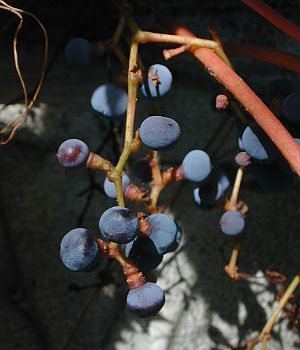
Distinguished by: The species is distinguished from P. vitacea by tendril morphology, leaves, and height: P. vitacea lacks adhesive disks, has leaves with 5 leaflets, and grows at most only a few feet tall. P. quinquefolia has leaves with 5 palmately-arranged leaflets and grows slightly taller (15-20m compared to 9-15m) than P. tricuspidata. Different from P. tricuspidata, Ampelopsis brevipedunculata has leaves that are usually more deeply lobed and its tendrils lack adhesive disks. In addition the fruits of A. brevipedunculata are a wide range of colors all on the same inflorescence (from white to yellow, pastel shades of green, lilac to amethyst purple, and turquoise to sky blue). Hedera helix climbs with adventitious rootlets produced on the stems and has black berries. Menispermum canadense lacks tendrils (climbing wit the stem apex) and usually bears entire leaves with shallow lobes. The fruit of M. canadense contains a single flattened crescent-shaped seed (2,18,20,21,24).
Other members of the family in Michigan (number species): There are 2 other species of Parthenocissus in Michigan: P. vitacea and P. quinquefolia. There are 2 other genera of Vitaceae in Michigan: Ampelopsis (1 species) and Vitis (4 species) (2,12).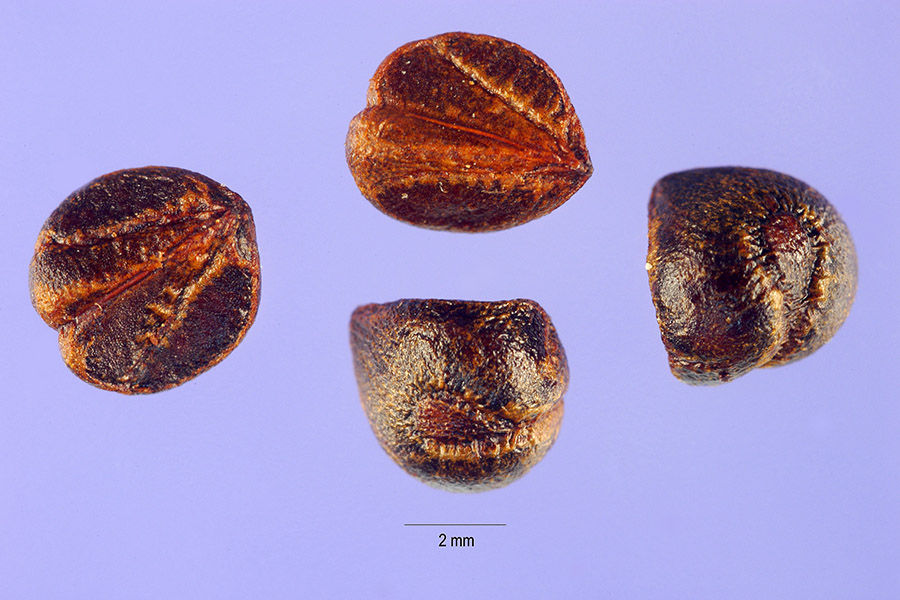
Ethnobotanical Uses: The sap of P. tricuspidata is used as a sweetener, or sugar substitute (19). No medicinal uses were discovered in the literature, but see below under Interesting Factoids.
Phylogenetic Information: Vitaceae is a core eudicot recently added to the Rosids. The Rosids are placed in the new order Vitales (APGIII). Vitales may be a sister group to all Rosids. Vitaceae is most closely related to the Crossosomatales, Geraniales, and Myrtales (26, 27).
Interesting Quotation or Other Interesting Factoid not inserted above:
A glycoside (piceid- (1à6)-B-D-glucopyranoside; PBG) from Parthenocissus tricuspidata was found to have antimalarial activity in mice. In this study, mice were injected with the malarial parasite chloroquine-sensitive strain of Plasmodium berghei. There was 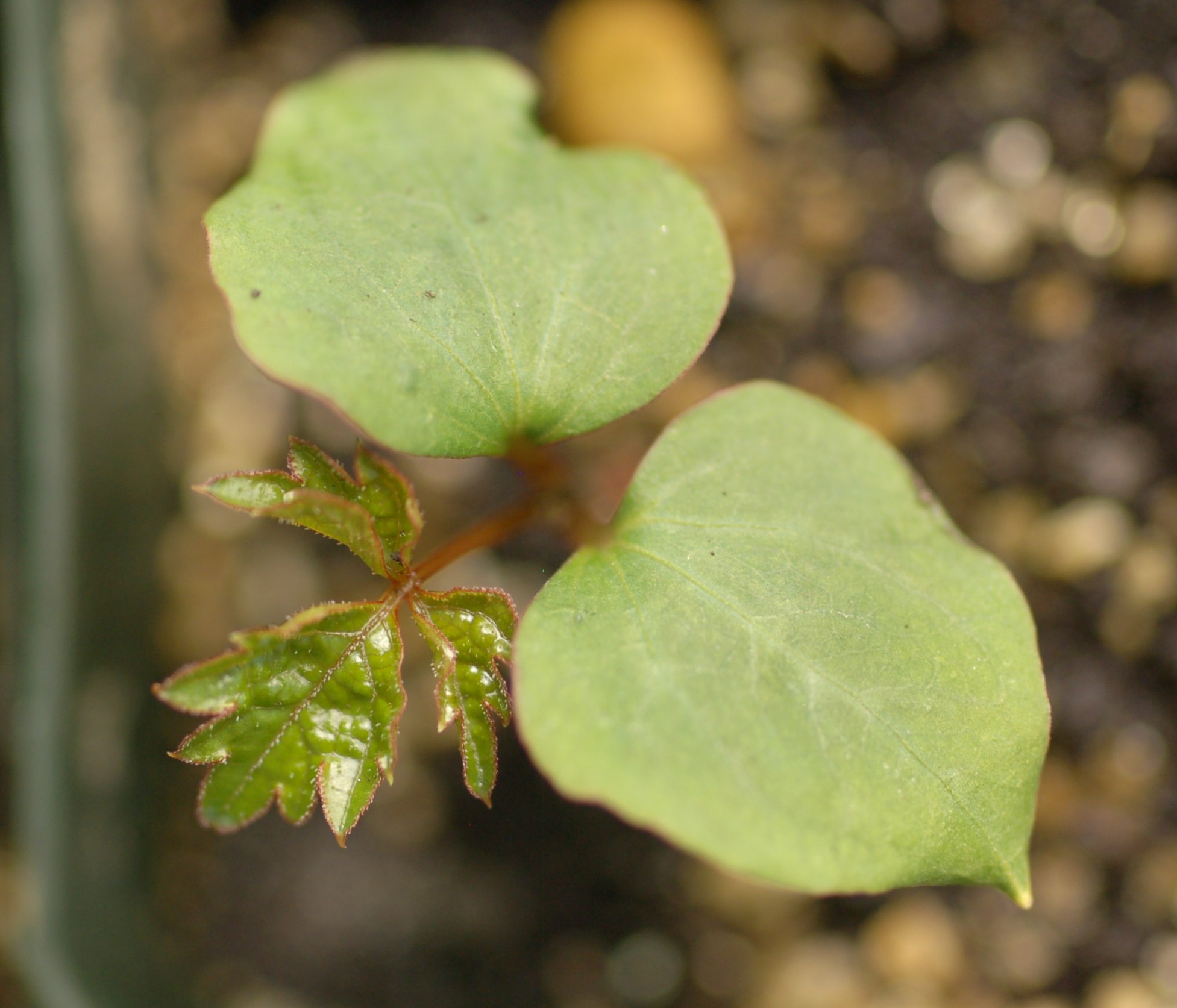 significantly longer mean survival time compared to when the standard drug, chloroquine, was injected (25).
significantly longer mean survival time compared to when the standard drug, chloroquine, was injected (25).
P. tricuspidata is known to grow on buildings at many universities throughout the country and is also found in Fenway Park in Boston. This climbing plant has important economic implications because it can thickly cover walls, which significantly reduces cooling costs (28).
The downside of the holdfasts, however is that they produce a super-adhesive glue. This glue is reported to be able to hold 260 times it’s own weight, as well as to sustain a pulling force 2,800,000 times higher than its own weight (30).
Literature and websites used:
- Young, J.A. and C.G. Young. 1992. Seeds of Woody Plants in North America. Portland, Oregon, USA: Dioscorides Press.
- Voss, E. G. 1985. Michigan Flora Part II: Dicots. Ann Arbor, Michigan, USA: Cranbrook Institute of Science.
- Braun, E. Lucy. 1967. The Woody Plants of Ohio: Trees, shrubs, and woody climbers, native, naturalized, and escaped. Columbus, Ohio, USA: The Ohio State University Press.
- Foote, L.E., and S.B. Jones Jr. 1989. Native Shrubs and Woody Vines of the Southeast: Landscaping Uses and Identification. Portland, Oregon, USA: Timber Press.
- Seymour, E.L.D., Ed. 1946. The New Garden Encyclopedia. New York, New York, USA: Wm. H. Wise & Co.
- Brand, Dr. Mark H. UConn Plant Database. http://www.ipm.uconn.edu/Plants/campus/uconn/dec/walk8/one/partri.html (10/15/09)
- Jensen, E., Seiler, J., Peterson, J. 2009. Parthenocissus tricuspidata Fact Sheet. http://www.cnr.vt.edu/DENDRO/dendrology/syllabus/factsheet.cfm?ID=301 (10/15/09)
- Rhodus, T. Parthenocissus tricuspidata. http://www.hcs.ohio-state.edu/hcs/TMI/Plantlist/pa_idata.html (10/15/09)
- Hickman, J.C. 1993. The Jepson Manual. Berkley and Los Angeles, California, USA: University of California Press.
- Brown, W.B. 1978. Composition of Scientific Words. Washington, D.C., United States: Smithsonian Institution Press.
- ITIS: Integrated Taxonomic Information System http://www.itis.gov/index.html Retrieved [10/15/09], from the Integrated Taxonomic Information System on-line database.
- USDA, NRCS 2008. The PLANTS Database, Version 3.1, National Plant Data Center, Baton Rouge, LA 70874-4490 USA. http://plants.usda.gov/java/profile?symbol=PATR6 (10/15/09)
- USDA, ARS, National Genetic Resources Program. Germplasm Resources Information Network – (GRIN) [Online Database]. National Germplasm Resources Laboratory, Beltsville, Maryland. URL: http://www.ars-grin.gov/cgi-bin/npgs/html/ taxon.pl?310629 (10/15/09)
- The Bay Science Foundation Inc. 2009. http://bayscience.org/Plants/P/Parthenocissus_tricuspidata/ (10/22/09)
- Junker, S. 1976. A scanning electron microscopic study of the development of tendrils of Parthenocissus tricuspidata. New Phytologist 77(3): 741-746.
- Posluszny, U. & Wilson, T. 2003. Complex tendril branching in two species of Parthenocissus: implications for the vitaceous shoot architecture. Canadian Journal of Botany 81(6): 587-597.
- Encyclopedia of Life. http://www.eol.org/pages/582342- 9 (10/15/09)
- Virtual Herbarium of the Chicago Region. The vPlants Project http://www.vplants.org/plants/species/species.jsp?gid=28712 (10/22/09)
- Plants For a Future, 1996-2008. http://www.pfaf.org/database/plants.php?Parthenocissus+tricuspidata (10/18/09)
- Fewless, Gary. University of Wisconsin in Green Bay. Herbarium Corfin Center for Biodiversity. http://www.uwgb.edu/biodiversity/herbarium/shrubs/mencan01.htm (10/18/09)
- Zhiduan, C. & Wen, J. 2007. Parthenocissus Planchon in A. Candolle & C. Candolle. Flora of China 12: 173-177.
- International Plant Names Index (IPNI) http://www.ipni.org/index.html (10/22/09)
- Solomon, J. 2006. W3TROPICOS VAST nomenclatural database. Missouri Botanical Garden. http://mobot.mobot.org/W3T/Search/vast.html (10/22/09)
- Global Invasive Species Database http://www.issg.org/database/ (11/30/09)
- Park, W, Lee, S, Moon, H. 2008. Antimalarial activity of a new stilbene glycoside from Parthenocissus tricuspidata in mice. Antimicrobial Agents and Chemotherapy 52(9): 3451-3453.
- Fernald, M. L. 1950. Gray’s Manual of Botany, 8th edition. New York: American Book Co.
- APG III 2009. An update of the Angiosperm Phylogeny Group classification for the orders and families of flowering plants: APG III. Botanical Journal Linnean Society 161: 105–121.
- Classy Groundcovers. 2009. http://classygroundcovers.com/item–Parthenocissus-tricuspidata-%7B24-Pots-3-1-2-in-%7D-Boston-Ivy–2058
- Gibson, Arthur. General Botany. http://www.botgard.ucla.edu/html/botanytextbooks/generalbotany/typesofshoots/tendril/fulltextonly.html.
- He,T., L. Zhang, H. Xin, and W. Deng 2010. Morphlogy and mechanics of the adhesive disc of liana Parthenocissus tricuspidata. Pure. Appl. Chem. 82(1):91-96.
- Tropicos.org. Missouri Botanical Garden. 13 Dec 2012 <http://www.tropicos.org/Name/34000008>
Image Credits (all used with permission):
1) Image of leaves and fruit courtesy of Dr. Brad Monroe at http://www.cuyamaca.edu/oh170/week1.asp
2, 3) Image of holdfasts and flower courtesy of W. John Hayden, Department of Biology, University of Richmond
4) Image of fruits and of seeds are courtesy of Dr. John Hilty, Illinois Wildflowers via Encyclopedia of Life at http://eol.org/pages/582342?image_id=1389309
5) Image of seeds from Steve Hurst, USDA, NRCS Plants Database via Encyclopedia of Life at http://eol.org/pages/582342?image_id=1389309
6) Image of seedling © Robyn J. Burnham, University of Michigan, Ann Arbor.
Primary Author: Andrea Friedman with edits and additions from Robyn J. Burnham
© Robyn J. Burnham, University of Michigan
For additional information on Michigan Plant Diversity web pages please contact Robyn J. Burnham via email: rburnham“at”umich.edu